Facebook ads can be a great way to connect with your target audience. Despite the hype around new industry players (TikTok, we’re looking at you), Facebook still holds the crown as the world’s largest social media platform. With almost 3 billion active monthly users, Facebook offers an unrivalled user base – creating huge opportunities for brand exposure.
In case you missed the memo, Facebook changed its corporate name to Meta in 2021 – an umbrella term for the various social platforms owned by the tech conglomerate. By advertising on Meta Ads, you can reach users across Facebook, Instagram and Messenger – creating a combined reach of 6 billion active monthly users.
Impressive, right?
But, the benefits are short–lived if you’re not reaching the right users, or optimising your ads with the wrong goal in mind for your business.
Read on to learn how to effectively advertise on Facebook, with actionable tips on:
- Setting budgets
- Choosing ad formats
- How to build a campaign
- Optimising campaigns for maximum results
- Why invest in Meta ads?
- Reach new users
- Precise targeting
- Versatility
- Performance insights
- How much do Facebook ads cost?
- The target audience
- Competition
- The campaign objective
- How much should I budget for Meta ads?
- Meta ad formats
- Image ads
- Video ads
- Stories ads
- Carousel ads
- Slideshow ads?
- Collection ads
- How to run Meta ads
- 1. Choose your campaign objective
- 2. Select your buying type
- 3. Set your budget
- 4. Create your ad set
- 5. Build your target audience
- 6. Choose your ad placements
- 7. Set brand safety controls
- 8. Choose your ad format and creative
- 9. Write your ad copy
- 9. Choose your CTA
- 10. Check your website tracking
- 11. Preview your ad and publish
- Ongoing management of Facebook advertising
- Final thoughts
Why invest in Meta ads?
Still not sure why your Paid Social strategy should include Facebook, Messenger or Instagram ads? Here are some key benefits of advertising on the platform.
Reach new users
Facebook and Instagram have a huge user base to advertise your brand and boost your digital presence – with many potential future customers using the social platform. Reaching new audiences is key to driving growth, by targeting new demographics that may not have previously heard of your brand.
Precise targeting
Meta Ads Manager has a wealth of precise targeting options available, enabling you to reach users who are most likely to have an interest in your business.
There are three types of audiences you can target:
- Core audiences: target users based on their demographics, interests and behaviours
- Lookalike audiences: target users who share similar characteristics to your existing customers.
- Custom audiences: retarget users based on their interactions with your brand, such as visiting your website.
Versatility
Meta’s Ads Platform provides a range of campaign objectives, from building brand awareness to driving purchases. This enables brands to achieve results which align with their business goals, whilst also making it possible to target users at each stage of the marketing funnel.
Once you choose a campaign objective, Meta will deliver your ads to users who are most likely to take the desired action. For example, if your campaign goal is to drive brand awareness, Meta will deliver your ads to the largest number of users who are most likely to recall your ad.
Performance insights
Meta’s Ad Platform provides comprehensive insights into campaign performance, ranging from upper funnel metrics (such as reach, ad recall, clicks, CPC) to lower funnel metrics (purchases, leads, CPA, ROAS). You can use this data to track performance in real–time and optimise towards top-performing audiences and ads to maximise your results – just be sure to focus on the metrics which align with your campaign goal.
How much do Facebook ads cost?
There’s no set rule when it comes to advertising on Facebook.
Ads are charged either on a CPM (cost per thousand impressions) or a CPC (cost per click) basis. For the majority of campaigns, advertisers pay for impressions.
The cost for these metrics can vary depending on various factors:
The target audience
It typically costs more to deliver your ads to a more narrow audience compared to a broader one. However, it can be more effective to reach audiences who are likely to have an interest in your business by leveraging Meta’s targeting options. For example, an engagement ring brand may benefit from targeting users aged 25–55 who live 50 miles from their showroom & have an interest in engagement rings – rather than broadly targeting all users aged 18–65 in the UK. The key is to strike a balance between targeting too broadly and being too specific.
Competition
It can be more expensive to deliver ads if your industry is competitive, with several brands competing to advertise to your target audience. For this reason, it can also be more expensive to advertise around particular holidays – such as Black Friday or Christmas – due to an influx of brands looking to advertise as consumer demand peaks.
The campaign objective
It can be cheaper to deliver ads if your campaign is optimised for upper–funnel objectives, such as driving brand awareness or traffic. However, if you’re looking to generate sales or leads, you may see costs rise. Meta delivers ads to users who are most likely to take the desired action – so, if you’re looking to drive sales, Meta’s delivery system will find users within your target audience who are most likely to make a purchase, based on their online behaviour. These audience sizes are more narrow and more valuable, which can make these campaigns more expensive to deliver. We recommend that you choose the campaign objective that best aligns with your business goals. Some will cost more, but they’ll drive the results you’re looking to achieve.
How much should I budget for Meta ads?
Meta requires a minimum budget to deliver ads consistently. Most campaigns should be allocated at least £1 per day – however, this can differ depending on campaign objectives and audience sizes. If your budget doesn’t meet the minimum requirements, you’ll see an alert. You may also see a recommendation if your budget isn’t high enough to achieve optimal results.
If you’re building a new campaign, we recommend starting small and then gradually increasing your budget once you gain some performance insights.
A key metric to keep an eye on is frequency, which indicates the average number of times a single user sees your ad per day. If you’re reaching new users, we recommend a frequency of 1–2 within a 7 day period, whilst remarketing campaigns can perform well with a frequency of up to 7. If your frequencies are above these levels, we advise reducing your budgets by 10–20% per day until they fall within the recommended range.
Another key thing to consider is the learning phase, which occurs when campaigns first launch. This is where Meta’s delivery system learns how to optimise your ads by trialling different target audiences, creative variations, placements and so on. Exiting the learning phase typically takes 50 optimisation events within a 7 day period – so we recommended allocating enough budget to your campaign to achieve this. However, be sure not to inflate budgets during this time to exit the learning phase more quickly – as this will provide the system with an inaccurate indicator of the people it should optimise for.
Meta ad formats
There are many different types of ad formats available on Facebook, Messenger and Instagram ads, enabling you to connect with your target audience in different ways.
Image ads
Image ads are easy to create, and they can be a simple and effective way to communicate with your target audience.
When creating assets for image ads, referring to Meta’s best practices is key. We’ve summarised these below:
- Have one focal point – convey your message simply and quickly by focusing on one clear element, such as a specific product. If you’re finding this difficult, consider using a video or carousel ad instead.
- Limit overlay copy – clean ads with minimal text have a greater impact. If you’re looking to add further detail for your target audience, this can be included within your ad copy.
- Maintain brand consistency – ensure that your ads have a consistent theme to boost brand recognition. You can achieve this by using your brand colours within creative, displaying your logo and keeping to one font style.
- Highlight people using your product – this can feel more authentic by naturally blending in with the content in users’ feeds. For example, instead of highlighting your product within creative, consider producing content that shows people benefitting from using your product.
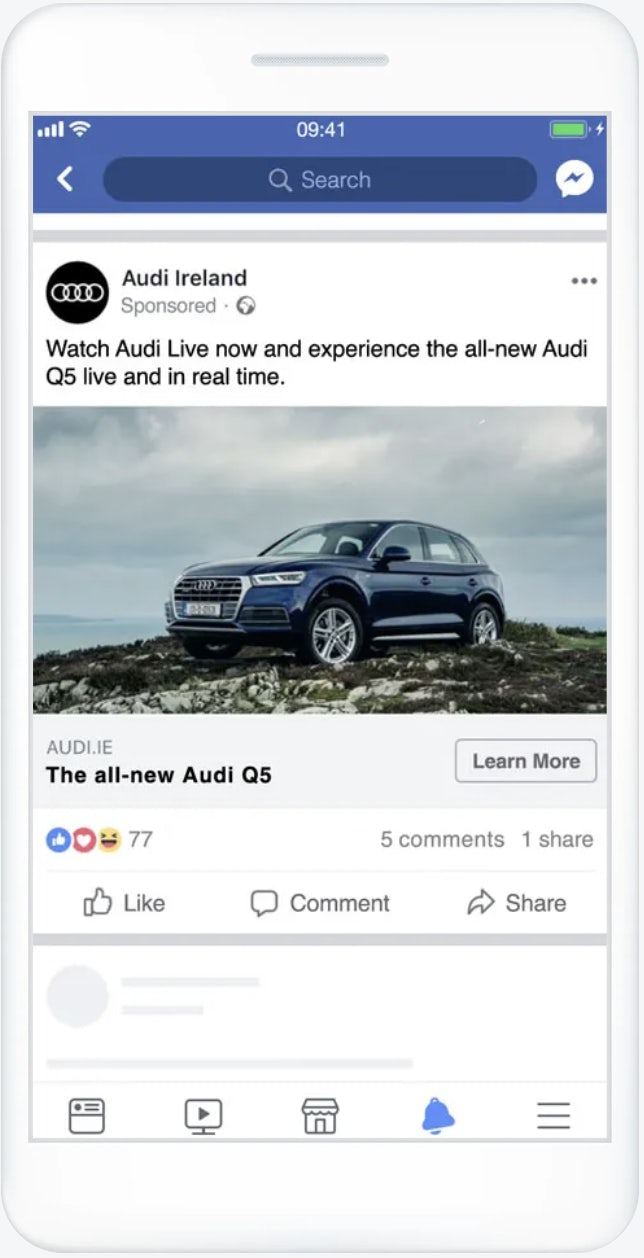
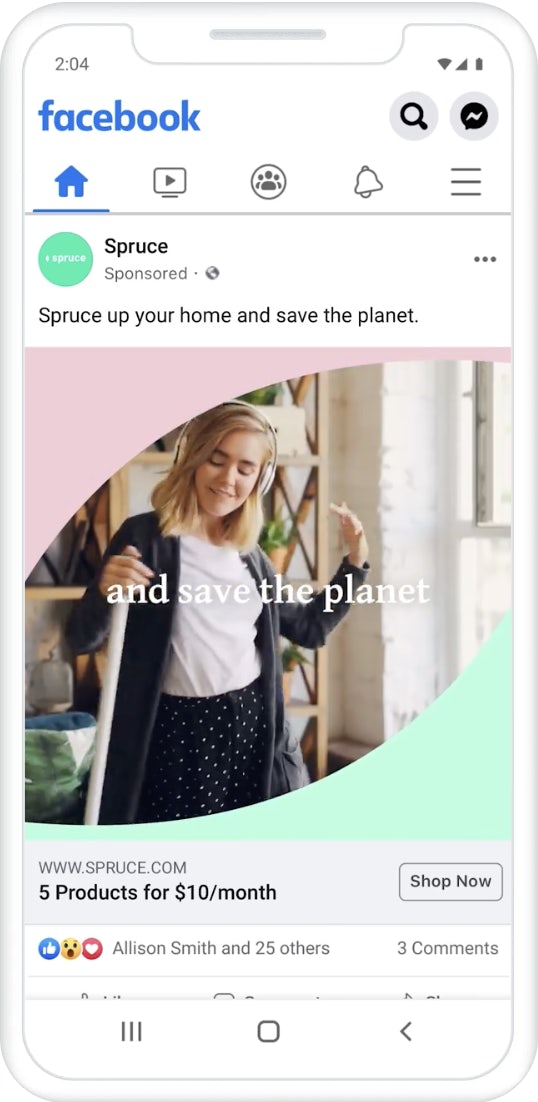
Video ads
Investing in video content is key for brands looking to connect with their target audience on Paid Social. Video is fast becoming the most popular form of content on social platforms – making up half the time people spend on Facebook.
Videos are particularly useful for upper–funnel objectives, and can be used for brand storytelling, product tutorials or showcasing user experiences.
We recommend creating videos no longer than 15 seconds to maximise user engagement, with attention spans on social media being typically short.
Stories ads
Stories ads are a full–screen, vertical ad format that can be made up of images, videos or carousels. This ad format isn’t delivered to users whilst they’re scrolling through their feed, but instead when they’re swiping through their Stories on Facebook or Instagram.
Stories can be more immersive compared to other ad formats, as they fill users’ screens – matching how they’re already interacting with their social network.
When creating assets for Stories ads, it’s important to tailor your design specifications to the full–screen format to maximise user engagement. Meta also advises that these assets are fast–moving and easy to understand.
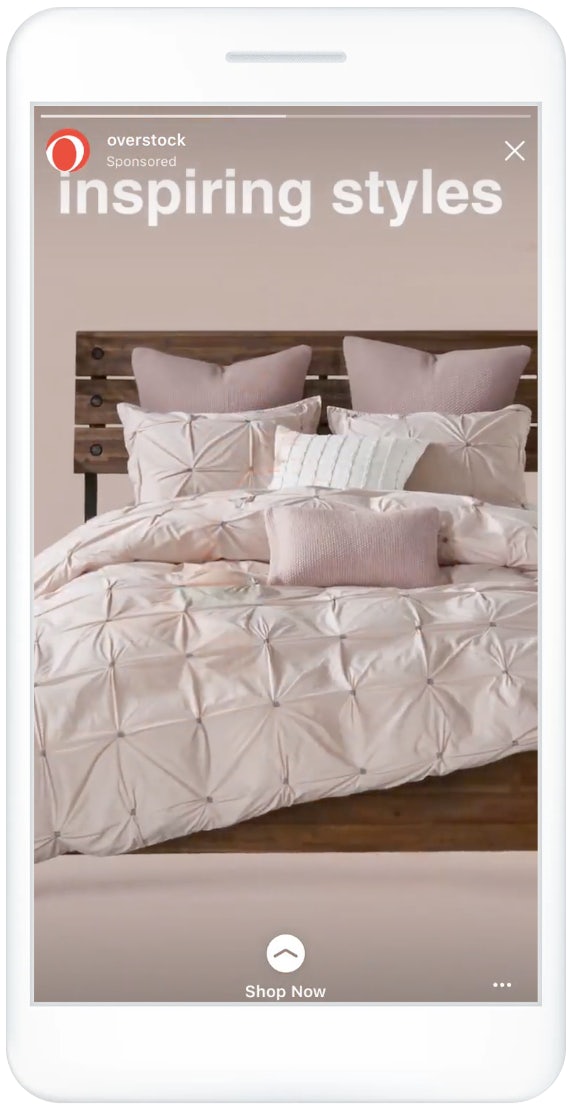
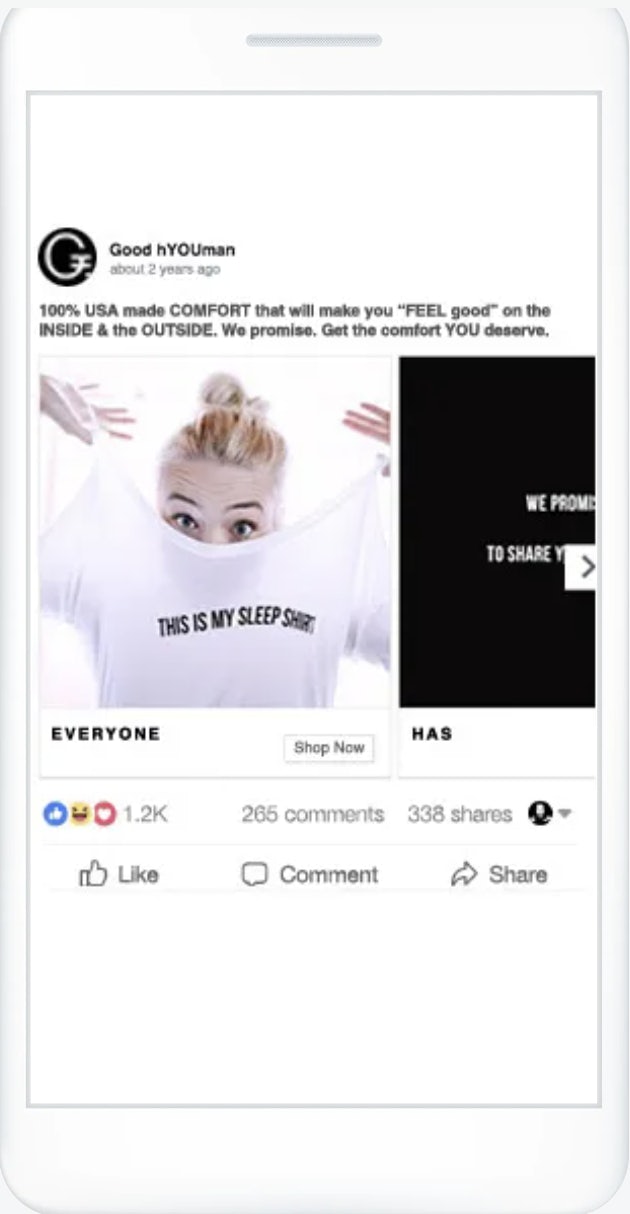
Carousel ads
Carousel ads highlight up to 10 images or videos within a single ad, each with its own headline, description and URL link. This format is ideal for guiding users through a process, showcasing different products or highlighting brand USP’s.
Slideshow ads
Slideshow ads transform static images into a video format which plays in a slideshow. This makes them ideal for producing video content without requiring a big budget or videography experience. Slideshows are also fast–loading, and they play well on every connection speed.
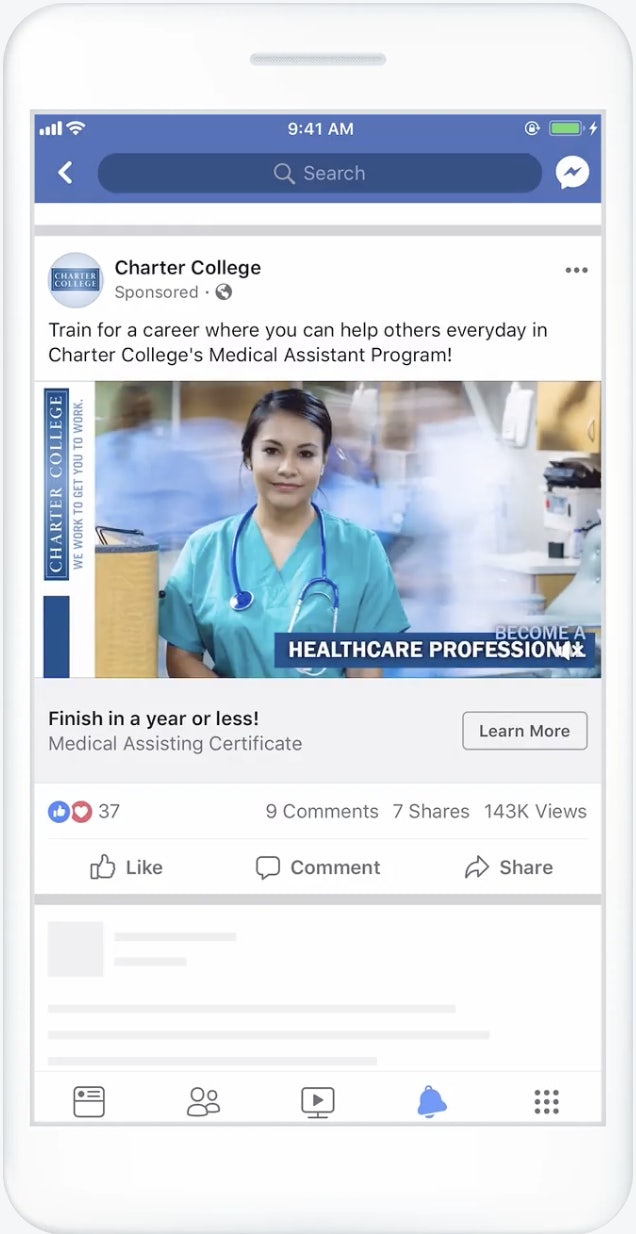
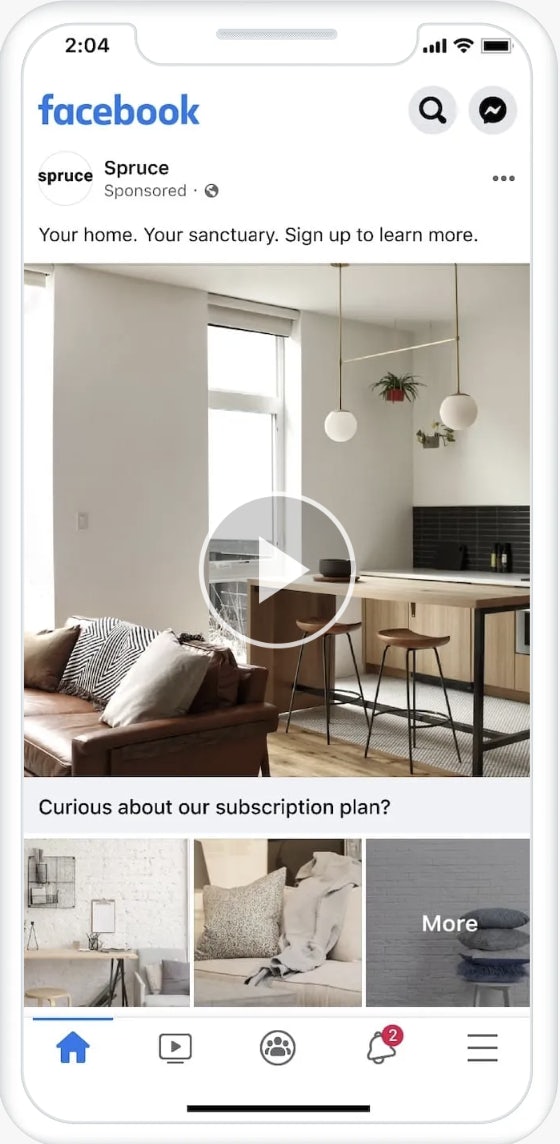
Collection ads
Collection ads enable users to discover your brand, browse your products or make a purchase. Each ad consists of a primary video or image with three smaller images in a grid layout. Once clicking through, users are taken to a fast–loading mobile experience – enabling them to purchase directly from the ad without leaving Facebook or Instagram.
Collection ads are ideal for bottom–funnel campaign objectives, particularly as marketers have the opportunity to integrate their product feed – enabling users to view various products in one place.
We recommend testing various ad formats within your Paid Social campaigns to gain some insight into which formats drive the best results for your brand.
However, each ad format requires specific design specifications, so it’s key that your creative assets are produced with these in mind (more on this below).
How to run Meta ads
Setting up your first campaign on Ads Manager can be a daunting prospect. Luckily, this guide will give you all the tools you need to get started.
1. Choose your campaign objective
First up, you need to decide what the overall goal of your campaign is. Is your business looking to achieve top–of–the–funnel objectives, such as driving brand awareness among new users – or bottom–funnel objectives, such as generating purchases from people who have previously interacted with your brand?
We recommend that you run a mix of upper and lower funnel activity. Whilst it can be really cost–effective to generate purchases from high-intent users, it’s also key that you’re building the funnel with new users to drive growth for your brand. By only running bottom–funnel activity, you’ll be limiting your audience sizes to people who are likely to convert – meaning that you’ll quickly hit a ceiling when looking to scale these campaigns.
A well-developed, balanced Paid Social strategy is key – enabling you to reach new audiences whilst nurturing your existing ones.

Here’s an overview of the campaign objectives available on Meta:
- Sales – find people likely to purchase your goods or services.
- Leads – collect leads for your business via messages, phone calls or signups.
- Engagement – find people who are more likely to engage with your business online, send a message or take desired actions on your ad or Page.
- Leads – collect leads for your business via messages, phone calls or signups.
- App Promotion – encourage people on mobile devices to install or take a specific action within your app.
- Traffic – increase traffic to an online destination of your choice. Send people to your website, app, or your Facebook or Instagram shop.
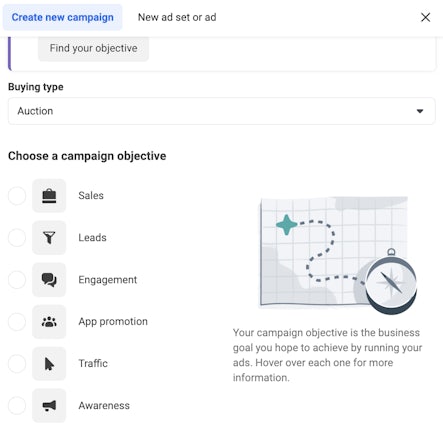
Next, name your campaign and declare whether your ad fits into any special categories like social issues or politics. Bear in mind that you’ll have limited targeting options available when running ads for special categories, but this is key for ensuring that your ads comply with Meta’s advertising standards. You may also need to provide some documentation, such as a passport photo, to run these ads – but this will be flagged by the platform.
2. Select your buying type
There are 2 buying types available on Meta Ads:
- Reach and Frequency – involves planning and buying your campaigns in advance. Predictions are provided for reach, frequency, spend and placement distribution before purchasing – which can be great for budget planning. However, this buying type is only available for awareness, traffic and engagement objectives.
- Auction – the default buying type. Each time there’s an opportunity to show an ad to someone, Meta uses an auction to determine the best ad to deliver depending on its bid, estimated action rate and ad quality. This buying type is available for all campaign objectives and offers more choice, efficiency and flexibility – but with less predictable results.
You can learn more about the ad auction here.
3. Set your budget
Input your budget and decide whether to use Advantage campaign budget – which allows Meta to proportion spend to each audience based on their performance and size. This tool reacts to changes very quickly, allowing advertisers to somewhat relax when it comes to budget allocation. We advise activating this to maximise performance, unless you have varying audience sizes or want more control over each audience’s budget.
If you see that Meta has allocated a small level of budget to one of your audiences, and you’d like to test it more thoroughly, you can also implement minimum spends in each ad set.
Next, you’ll need to decide whether to set a daily budget or a lifetime budget. If you have an end date in mind for your Paid Social activity, it may be worthwhile using a lifetime budget – but otherwise, choosing a daily budget can be more efficient as it avoids having to increase your budget each time the lifetime budget is reached. If your lifetime budget is reached and your campaign is paused as a result, this can also reset the learning phase which can cause more unstable results in the short term.
Here, you can also decide whether to run an A/B test, which enables you to test two versions of a campaign strategy by changing variables such as creative, ad copy, audiences or placements. Find out more about A/B testing on Meta.
4. Create your ad set
First, set your performance goal – which Meta uses to report on performance and optimise your ads. This can vary depending on the campaign objective. For example, if you choose the traffic objective, you can decide whether to measure clicks or landing page views (which tracks each time a user lands on your destination URL and fully loads the page – as opposed to simply clicking the link).
Next up, choose whether to activate dynamic creative. This feature creates different ad combinations of creative and copy using Meta’s machine learning system to maximise performance. We’ve seen some success when trialling dynamic creative ad sets, but it can sometimes create poor combinations when providing Meta with assets tailored to different formats – for example, by showing a vertical story–optimised asset in the in–feed placement – which may harm your brand identity and campaign results. To avoid this, you can steer clear of story–optimised assets and just use in–feed/square assets – but this ultimately depends on how important it is for your brand to be using full screen, vertical assets within the story placement. If you’re unsure, we advise split–testing both types of ad sets to see which drives the best performance for your brand.
You can also set your ad schedule here, by either providing an end date for your Paid Social activity, or choosing to keep it ongoing. This ultimately depends on whether your content has a time limit, for example if you’re promoting an upcoming event, or whether you’re running content that can run continuously.
5. Build your target audience
Here, you can build your audiences – which will differ depending on whether you’re looking to reach new users or engage existing audiences through retargeting activity.
If you’re looking to reach new users, you can use Meta’s detailed targeting options to refine your audience based on their demographics, interests and behaviours. Meta has a wealth of interests available, enabling you to target users who are most likely to engage with your brand. These can range from general interests like travel to more niche interests such as treasure hunting.
You can also apply exclusions to ensure that you’re targeting users effectively. For example, a package holiday company looking to drive purchases from people with an interest in travel may exclude users who work for certain airline companies – as these users may have this interest due to their field of work, rather than wanting to book a holiday.
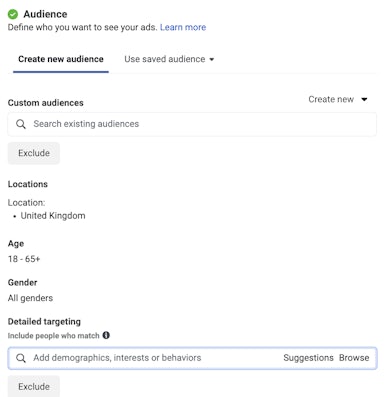
Meta’s audience definition feature will provide an estimate of how big your audience is based on the targeting options chosen. As we touched on earlier, the idea is to create a fairly broad audience – targeting users who are likely to have an interest in your brand without being too specific – as this can result in narrow audiences which can increase costs.
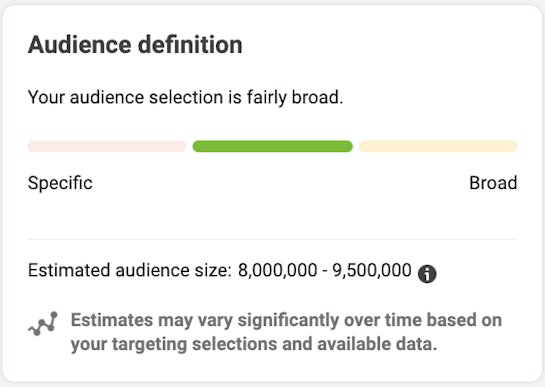
To ensure that you’re reaching new users and spending your budget efficiently, you may also want to exclude past website visitors or people who purchased recently from your business. You can achieve this by building a custom audience of these users, either using pixel data or first–party data through CRM integration.
Yet to implement this? Learn how to install the Meta Pixel.
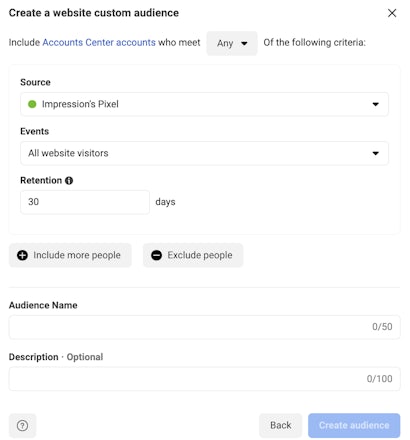
Another feature available is lookalike audiences, which consist of users who share similar characteristics to your existing customers, enabling brands to reach new users who are likely to have an interest in their products.
You can build a lookalike audience by using pixel data and selecting how broad you want the audience to be – ranging from 1% to 10%. If you choose a 1% lookalike, these users will be most similar to your existing customers – whereas, increasing this percentage creates a bigger and broader audience.
Choosing how ‘alike’ you want your audience to be will depend on your campaign goals and budget. As with all aspects of Paid Social advertising, the key is to test, test, test – experimenting with different audiences to determine which drives the biggest impact.
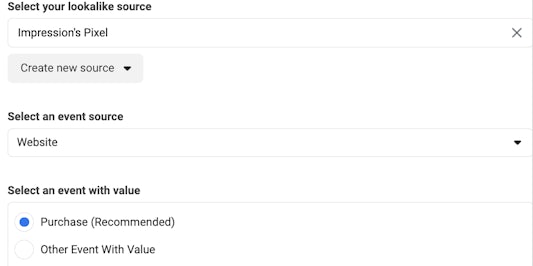
If you’re looking to retarget existing audiences, you can build custom audiences based on users’ interactions with your brand. These interactions can include users who visited your instagram profile, or even past website visitors.
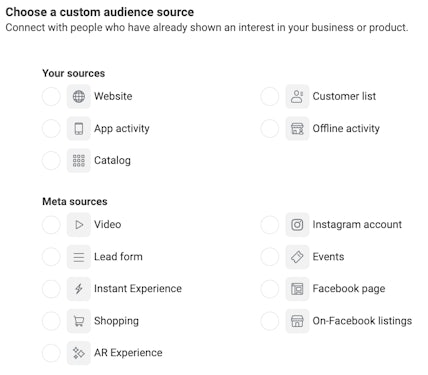
When building retargeting audiences, you may want to consider segmenting these based on intent. For example, one audience could consist of warm users who visited your website recently but didn’t purchase, with ads encouraging these users to revisit your website. You could then take this a step further, by building another audience with high intent users who added an item to their cart recently but didn’t purchase. Here, you could leverage your catalog and advertise a discount code to incentivise sales.
A final note on audience targeting – testing different audiences is key to determine which drives the best results for your business. If some audiences are performing significantly better than others, you can optimise towards these by pausing any under–performing audiences – enabling Meta to proportion more spend towards your top performers to maximise results.
6. Choose your ad placements
When advertising on Meta, your ads can be delivered on Facebook, Instagram, Messenger and Audience network across the below placements:
- Feeds
- Stories & Reels
- In–Stream ads
- Search results
- Messages
- Instant Articles
- Apps & Sites
We recommend advertising across multiple placements by using the ‘Advantage+ placements’ feature, which can increase your reach and improve performance by enabling Meta to deliver your ads based on where they’re likely to perform best – making the most of your budget.
However, if you’d like more control over where your ads are delivered, you can also choose your placements manually.
You can also review which placements are performing best by using the breakdown tool in Ads Manager. If you have any placements which are spending high amounts but not performing well against your KPIs, you can pause them – it’s as simple as unticking a box.
Take a look at the official guide to Meta Ads placements.
7. Set brand safety controls
Scroll down to the brand safety section if you want to prevent your ad from appearing alongside any type of content that would be inappropriate. For example, you can choose to upload a list of URLs to prevent your ads from being delivered there.
Check out Meta’s guide on brand safety controls.
8. Choose your ad format and creative
Now we reach the creative part!
First, select your ad format. By selecting ‘manual upload’, you can choose from the formats we touched on earlier – single image or video, carousel or collection.
If you’re looking to drive sales, you can also opt to build a dynamic product ad by using media from your catalog.

Next, upload your ad creative and crop it to fill each placement. We recommend uploading a different file for Feeds, Stories and Facebook Search Results – using the correct dimensions for each – to ensure that your creative is optimised for these placements. Unsure which dimensions to use when building your assets? Check out Meta’s guide to image specs.
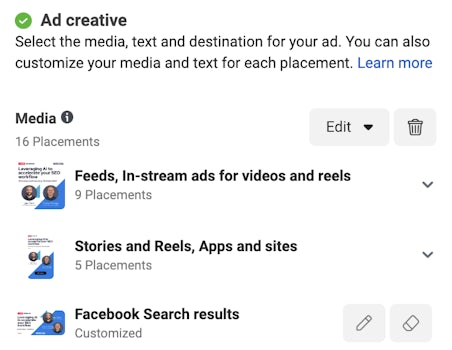
If you’ve opted to use your catalogue, you won’t need to upload any ad creative – as Meta will dynamically advertise items from your product feed based on whether each user is likely to engage with them. This can be particularly effective in retargeting campaigns, by reminding users of the products they interacted with on your website. Find out more about creating a catalogue on Meta.
It’s key to align your creative with your campaign objective. If you’re building a brand awareness campaign, ad creative which provides an insight into your brand through videos or carousels can be really effective and drive high recall rates. However, if you’re looking to drive sales, this type of content is unlikely to encourage users to purchase at a profitable rate.
9. Write your ad copy
Next up, ad copy!
Ad copy within Meta Ads consists of:
- Primary text
- Headline
- Description
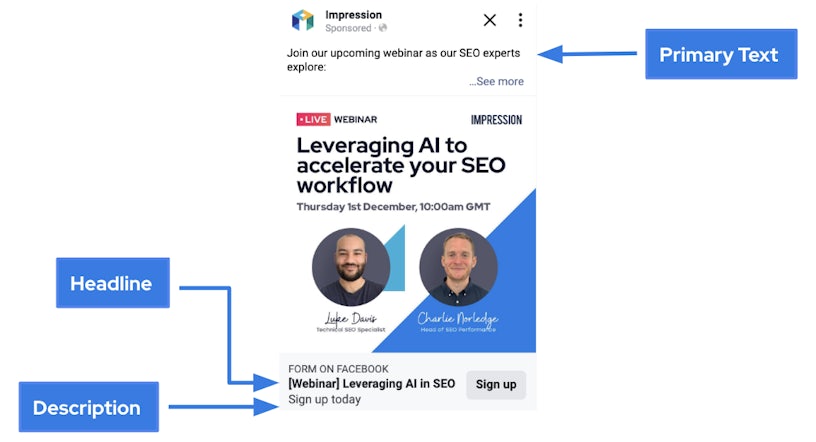
When writing your ad copy, bear in mind that it may be truncated when users see your ad – so it’s key to grab their attention in the first line. Meta recommends a character length of 125 or less for primary text, 40 characters or less for the Headline and a maximum of 25 characters for the description.
In Ads Manager, you can include up to 5 different copy variants for each ad, with Meta’s machine-learning system delivering different variations to your audience based on what they’re most likely to respond to.
We recommend writing different styles of ad copy to learn what drives the best performance for your band. You can test aspects such as emojis, varying copy lengths, the structure of your copy and more – as seen in our example below, which is promoting a blog post on our website.
It’s also key to write ad copy that aligns with your campaign objective. If you’re building a traffic–optimised campaign, your ad copy should encourage people to visit your landing page – which could be a blog or helpful guide. Whereas, asking people to shop your product range may not be the best fit here.

9. Choose your CTA
Now that you’ve entered your ad copy, it’s time to input your landing page URL and choose the call to action (CTA) that best aligns with your campaign objective and what you’re trying to achieve.
There is a wide range of CTA buttons to explore.

10. Check your website tracking
Next, make sure that your tracking is set up to track on–site events once users click through your ad. This is key to understanding how your ads are performing, enabling you to optimise your campaign towards top performers. You’ll also have the option to set up app and offline events if applicable, and input a unique URL parameter so you can identify how each ad performed using Google Analytics.
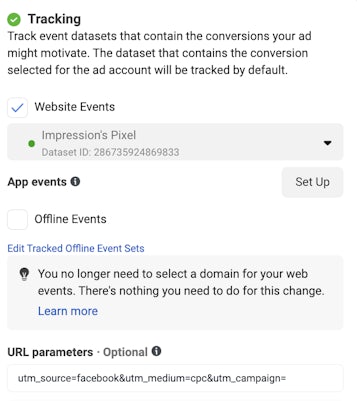
11. Preview your ad and publish
Finally, spend some time reviewing your campaign to ensure that it’s appropriate for your objective and target audience. You can also preview your ad to see how it appears for users on each placement.
Once you’re happy, click publish! Your campaign will be reviewed for any disapprovals, meaning that it may take some time to go live. If you’re running any urgent activity, such as a last-minute sale, you may want to consider building your campaign in advance to ensure that your ads are running during the sale. Once your campaign is up and running, it will go through the learning phase – until roughly 50 optimisation events are delivered within a 7-day period.
We recommend building a few ads per audience to test different variants. Whilst one creative variation may perform well, others may drive poor engagement from your target audience. However, it’s key that you don’t run too many ads at once to avoid spreading your budget too thinly – as Meta will need to allocate enough budget to each ad to thoroughly test it.
Ongoing management of Facebook advertising
The initial setup of your campaigns is just the beginning of advertising on Facebook or Instagram – the bulk of the work is spent optimising your ads, whilst also testing different variants to understand what your audience engages most with.
We recommend a test-and-learn approach for Paid Social advertising – testing different audiences, ad formats, creative styles, ad copy variants or even landing page URLs to see what performs best for your brand.
However, it’s key that you limit your tests to one variable at a time to pinpoint which drives an uplift in performance. It’s also important to test these variables over a long period of time – ensuring that Meta proportions enough spend on each style of ad to get a solid understanding of which is performing best. Testing variables over a long time period also ensures that the learning phase doesn’t impact results – as performance can be more unstable whilst Meta is learning how to best optimise your ads.
By testing different ad variants, you can use these insights to help guide future decision-making and improve your Paid Social performance moving forward.
Final thoughts
In this guide, we’ve covered the advantages of incorporating Facebook in your Paid Social strategy, how to set up a campaign in Ads Manager and some actionable tips on optimising your campaigns for maximum results.
At Impression, we’ve worked with a wide range of B2C and B2B businesses to reach desired targeted demographics through Facebook and Instagram. Head over to our Facebook advertising services page to find out more.
Looking for strategic advice? Get in touch to find out how we can help your business choose the best advertising approach for your business goals.
To keep up–to–date, check out our paid social media blogs.



